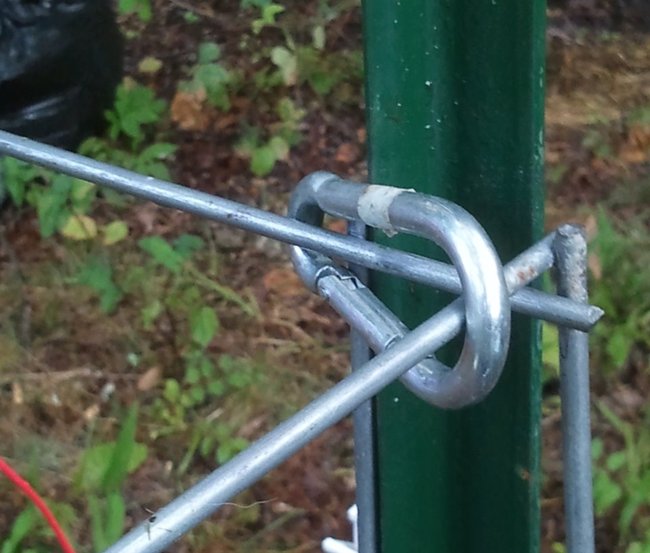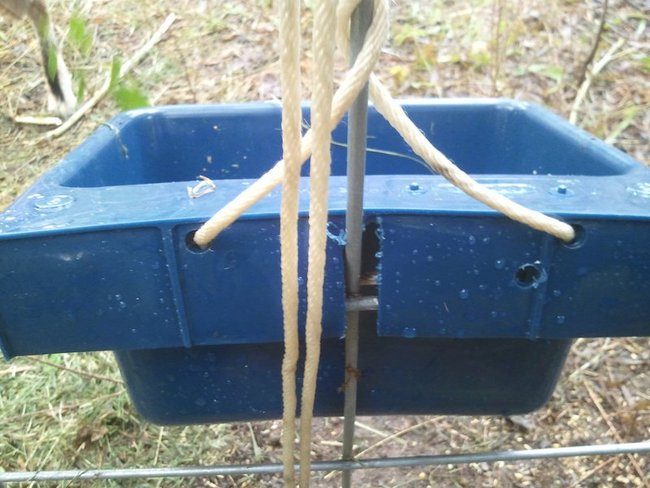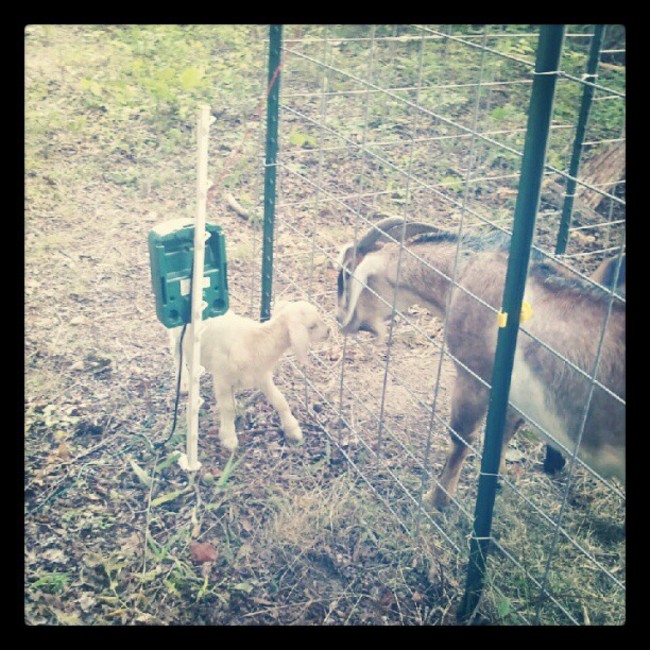 Electric fence insulator, gate handle and hot wire clip
Electric fence insulator, gate handle and hot wire clip
The last post on the bucks omitted a lot of the little details about the pen that we just made up on the fly, but that might be helpful for someone looking to build a pen. Before we started frequenting the Co-Op and Tractor Supply I never knew most of the stuff we use everyday even existed. I hope that by sharing the details other readers who are interested in the little stuff can get a better idea of exactly how it's all put together. I'd also love to hear feedback and what other people have done that worked well for them.
As you can see in the photos above and below, we put an electric wire around the top of the cattle panel using 2" insulator attachments that we got from Tractor Supply. The purpose having it stick 2" inward is so when the bucks climb on the fence they get zapped on the head and learn not to do that. If they are allowed to climb the fence will slowly lean over and they'll be able to climb out (and it will look ridiculous). At each gate there is a gate handle so we don't have to duck under the wire if we don't want to or if we need to bring something into the pen.
 Gate attached at top with carabiner
Gate attached at top with carabiner
For the entrance and exit gates we cut off a piece of cattle panel equal to the width between t-posts at attached it with zip ties. It's a cheap and easy way to cut a simple gate. On the other side of the gate we used large carabiners as locks. We have one near the bottom and one near the top. I debated using three carabiners, but so far two has worked well.
For the energizer we use a Stafix X2 attached to a marine deep cycle battery with two ground rods . We use two grounds to ensure it's grounded well (without which the zap would be weaker) and it also helps protect the energizer against frying in case lightning strikes.
 Goat hay/forage feeder made of bent cattle panel, attached with carabiner and rope at top
Goat hay/forage feeder made of bent cattle panel, attached with carabiner and rope at top
The hay feeder I made out of a small piece of bent cattle panel. I cut off some cattle panel, stepped on one end and bend the other end around toward me. When it was at a half-circle I stopped. I took two fence ties and linked the bottom to the cattle panel fence. At the top I used a carabiner so that I could open and close the feeder easily. We tied some rope to the top of the feeder connecting it to the top of the fence. That way when I unlock the carabiner the feeder won't fall all the way open and spill what's in there. Instead, the rope is tied at a length to where the feeder opens halfway up. That makes it easy to drop in new hay and tree branches.
 Mineral feeder with slit in back to attach to cattle panel and rope attachment to fence
Mineral feeder with slit in back to attach to cattle panel and rope attachment to fence
For mineral and grain feeders we took some small grain buckets and cut a slit down the middle in the back. That allows the bins to hang on the cattle panel. However, the goats kept knocking it off and spilling their minerals (as seen in the photo above), so I needed a better way to attach it to the fence. I took a drill and put a couple holes in the back and tied the bins to the fence with a rope. Now if they knock off a bin it just swings and it doesn't spill. It also keeps the goats from peeing and crapping in the bins, which animals are apt to do with just about anything that falls on the ground.
And for a feel-good photo here's Willow meeting Gozer. She's doing great and recently eclipsed the 10lb mark. When we got her she was about 3lbs.


